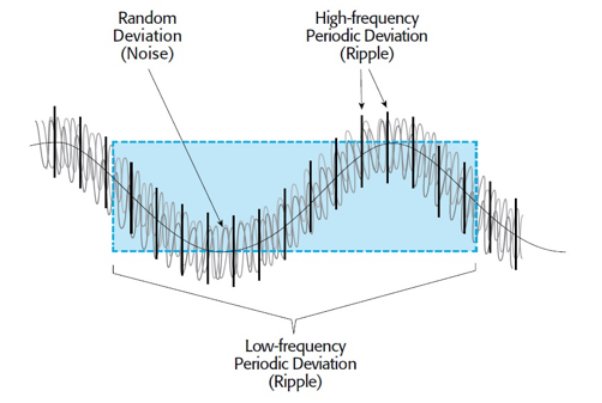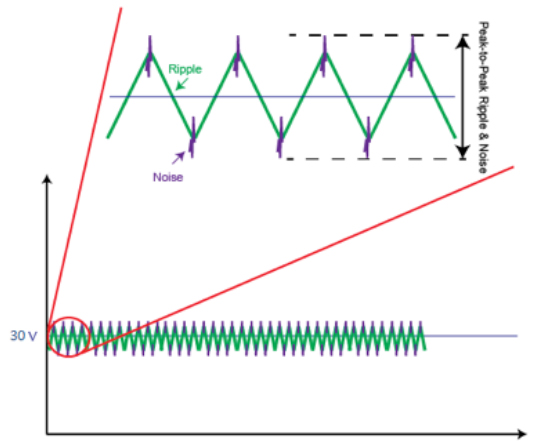What is LED Driver's Output Ripple and Noise?
An AC waveform can be identified on the DC output of a LED Drivers, which is shown in there are two AC components, also known as Ripple and Noise (R&N) on the DC output. The first one, coming from sine wave rectification, is at a low frequency which is 2 times of the input frequency; the second one is at high frequency which is from the switching frequency. as shown in Figure 1.  Figure 1. Component of AC form The ripple exists because, during a portion of the converter's operating cycle, energy is transferred to the secondary from the primary and the output voltage increases slightly. During the time interval when there is no energy transfer to the secondary, the load current is supplied by stored energy in the output capacitance and inductance of the converter, and the output voltage decreases slightly as this energy is depleted. Ripple is a low frequency component and will be occur at the same as the converter operating frequency, or some multiple thereof. Noise is much more variable and harder to predict than ripple. It is caused by ringing in parasitic inductances due to the large values of di/dt that occur internally in a switching converter. The noise is much higher frequency than the ripple and can be up into the MHz range. Noise occurs in the form of "bursts" at the time of switching activity in the converter, so therefore appears to be superimposed upon the peaks and valleys of the ripple waveform as shown in Fig 2.
Figure 1. Component of AC form The ripple exists because, during a portion of the converter's operating cycle, energy is transferred to the secondary from the primary and the output voltage increases slightly. During the time interval when there is no energy transfer to the secondary, the load current is supplied by stored energy in the output capacitance and inductance of the converter, and the output voltage decreases slightly as this energy is depleted. Ripple is a low frequency component and will be occur at the same as the converter operating frequency, or some multiple thereof. Noise is much more variable and harder to predict than ripple. It is caused by ringing in parasitic inductances due to the large values of di/dt that occur internally in a switching converter. The noise is much higher frequency than the ripple and can be up into the MHz range. Noise occurs in the form of "bursts" at the time of switching activity in the converter, so therefore appears to be superimposed upon the peaks and valleys of the ripple waveform as shown in Fig 2.  Figure 2. Output Ripple & Noise Note: The home station partial articles originate from the network
Figure 2. Output Ripple & Noise Note: The home station partial articles originate from the network
 Figure 1. Component of AC form The ripple exists because, during a portion of the converter's operating cycle, energy is transferred to the secondary from the primary and the output voltage increases slightly. During the time interval when there is no energy transfer to the secondary, the load current is supplied by stored energy in the output capacitance and inductance of the converter, and the output voltage decreases slightly as this energy is depleted. Ripple is a low frequency component and will be occur at the same as the converter operating frequency, or some multiple thereof. Noise is much more variable and harder to predict than ripple. It is caused by ringing in parasitic inductances due to the large values of di/dt that occur internally in a switching converter. The noise is much higher frequency than the ripple and can be up into the MHz range. Noise occurs in the form of "bursts" at the time of switching activity in the converter, so therefore appears to be superimposed upon the peaks and valleys of the ripple waveform as shown in Fig 2.
Figure 1. Component of AC form The ripple exists because, during a portion of the converter's operating cycle, energy is transferred to the secondary from the primary and the output voltage increases slightly. During the time interval when there is no energy transfer to the secondary, the load current is supplied by stored energy in the output capacitance and inductance of the converter, and the output voltage decreases slightly as this energy is depleted. Ripple is a low frequency component and will be occur at the same as the converter operating frequency, or some multiple thereof. Noise is much more variable and harder to predict than ripple. It is caused by ringing in parasitic inductances due to the large values of di/dt that occur internally in a switching converter. The noise is much higher frequency than the ripple and can be up into the MHz range. Noise occurs in the form of "bursts" at the time of switching activity in the converter, so therefore appears to be superimposed upon the peaks and valleys of the ripple waveform as shown in Fig 2.  Figure 2. Output Ripple & Noise Note: The home station partial articles originate from the network
Figure 2. Output Ripple & Noise Note: The home station partial articles originate from the network